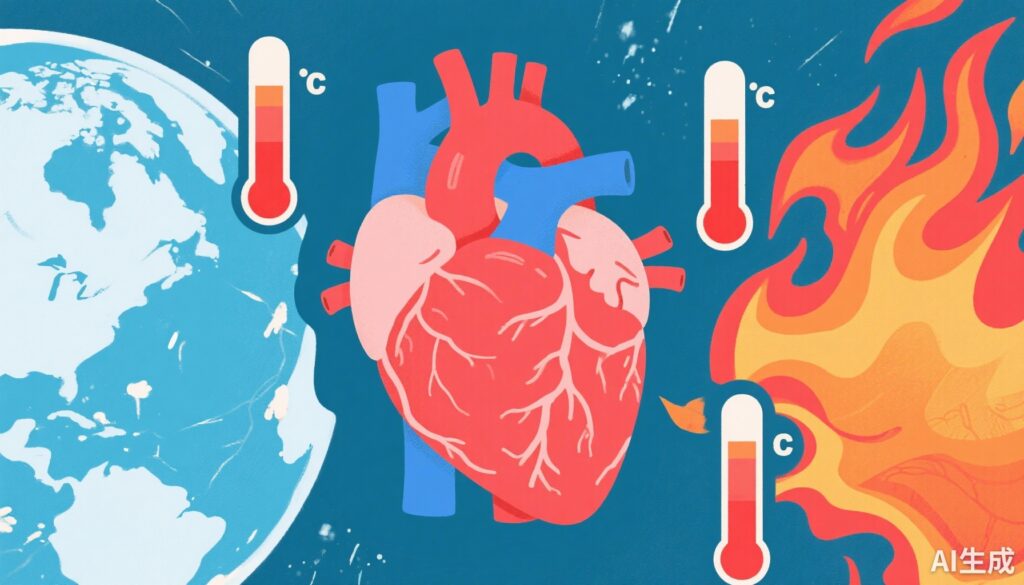Introduction
Heart failure (HF) is a chronic and complex condition affecting millions worldwide, characterized by the heart’s inability to pump blood effectively. Patients with HF are particularly vulnerable to environmental stressors, including temperature extremes. Temperature fluctuations have been associated with adverse health outcomes, but the extent of their impact on HF patients, especially in high-latitude countries like Sweden, has not been fully elucidated.
In the context of climate variability and the ongoing global warming, understanding how short-term exposure to temperature variations influences mortality among HF patients is vital for developing targeted interventions. This article discusses a comprehensive nationwide study from Sweden, examining the associations between ambient temperature and mortality in this sensitive population.
Study Background and Clinical Relevance
Climate change has led to increased incidences of extreme weather events, including cold snaps and heatwaves. Patients with HF often have compromised cardiovascular resilience, making them susceptible to environmental stressors that can exacerbate their condition. Previous studies have shown associations between temperature and mortality in general populations; however, data specific to high-latitude populations and HF patients are scarce.
The clinical significance lies in the potential to inform physician guidance, public health policies, and climate adaptation strategies aimed at reducing temperature-related mortality in vulnerable groups.
Study Design and Methodology
This investigation was a nationwide, time-stratified case-crossover study conducted in Sweden, covering the years 2006 to 2021. The study population comprised 250,640 individuals with a diagnosis of HF who died during this period, identified via the Swedish National Patient Register and the Cause of Death Register.
Exposure assessment involved using daily mean ambient temperature data at a high-resolution 1 × 1 km spatial grid. To account for regional adaptation, temperature exposures were defined based on municipality-specific percentiles, with the 2.5th percentile indicating low temperatures and the 97.5th percentile representing high temperatures.
The primary outcomes were all-cause mortality and cardiovascular mortality. The case-crossover design enabled control for individual fixed characteristics, comparing each individual’s temperature exposure prior to death with control periods.
Key Findings and Results
The analysis revealed a U-shaped association between short-term ambient temperature and mortality among HF patients, indicating increased risk at both temperature extremes.
Over the entire study period, the odds ratio (OR) for all-cause mortality associated with low temperatures was 1.130 (95% CI, 1.074-1.189), suggesting a 13% increased risk. High temperatures were also associated with increased mortality, with an OR of 1.054 (95% CI, 1.017-1.093).
Similarly, for cardiovascular mortality, low temperatures showed a more pronounced risk with an OR of 1.160 (95% CI, 1.083-1.242). High temperatures’ association was significant mainly during 2014-2021, with an OR of 1.084 (95% CI, 1.014-1.159), and the risk appears to have increased over time.
Subgroup analyses indicated that male patients, individuals with diabetes, and diuretic users were more susceptible to low-temperature mortality. Conversely, high temperature posed a higher risk in patients with atrial fibrillation or flutter, especially when exposed to elevated ozone levels.
Expert Commentary
These findings underscore a critical public health concern: climate-related temperature fluctuations pose a significant risk to HF patients, even in colder high-latitude environments. The increasing mortality risk associated with high temperatures over time suggests that adaptation strategies—such as heat-health warning systems, patient education, and environmental modifications—are urgently needed.
Limitations include potential residual confounding factors, lack of individual behavior data (e.g., use of heating or cooling devices), and the observational nature of the study. Nonetheless, the robust nationwide data and high-resolution exposure assessment enhance the applicability of these results.
Mechanistically, temperature extremes can induce hemodynamic stress, dehydration, and inflammatory responses, aggravating heart failure decompensation. These insights support integrating climate considerations into HF management guidelines and public health planning.
Conclusions and Future Directions
Short-term exposure to both low and high ambient temperatures significantly increases mortality risk among Swedish patients with HF. The rising impact of heat exposure warrants strengthening adaptation strategies and personalized risk assessments. Future research should explore intervention efficacy, behavioral adaptations, and the role of environmental policies in mitigating temperature-related health risks.
This study highlights the urgent need for healthcare systems and policymakers to recognize climate change as a modifier of cardiovascular health. Protective strategies tailored to vulnerable populations can save lives and reduce healthcare burdens in the era of changing global temperatures.



